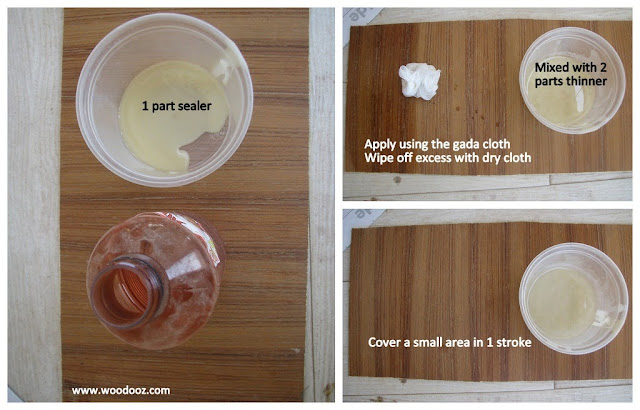Category :
Wood finishing
Sunday, July 21, 2013
Before looking at how to use the sanding sealer, do understand three important things :
Complete guide to wood staining
|
Materials required
- Sanding sealer
- NC Thinner
- Gada Cloth (for applying the sealer)
- Sand paper (220 grit)
All the above materials are easily available in the local hardware store.
 |
| Materials required - Sealing Wood |
Procedure
- Pour 1 part of sanding sealer in a bowl
- Mix 2 parts of NC thinner to the sealer
- Stir thoroughly to ensure the mix is consistent
- Dab the gada cloth in the mix and apply it on the surface of the wood
- Cover a small area in one stroke
- Before the layer dries, wipe off the excess sealer using a dry cloth
- Using the same method, apply the sealer across the entire surface area of the wood
- Allow it about 1-2 hours of drying
- Lightly sand the dried surface of the wood (Remember ? It is a sanding sealer)
- Apply two to three coats of the sealer to achieve a really smooth surface. Remember to sand in between coats.
 |
| How to seal wood |
This sets the surface ready for the stain to be applied. The application of stain on the surface of the wood is very similar to that of how the sealer is applied. Will very soon post the stain application procedure. Meanwhile, do leave us a feedback in the comments section. If you think, staining can be done in a different and easier way, feel free to leave me a comment.
Sunday, January 08, 2012
Before getting into the how tos of Priming and Painting wood, it helps to understand a little bit about the difference between wood paints and stains. This tutorial is particularly useful for your everyday small wooden DIY projects while it can also be extended to bigger ones like your furniture.
Note: This post only addresses painting on bare wood. The technique is different when an already finished wood needs to be repainted.
Why is priming required on wood ? (Back to Top)
- Priming is essential to provide the undercoat and topcoat of paint an even surface
- It allows for uniform absorption of paint, helps cover the grains and pores and thereby enables a flat, opaque, and smoother finish.
Some safety pre-requisites (Back to Top)
Materials and consumables required (Back to Top)
Primer allows for uniform absorption of paint, helps cover the grains and enables a flat and smoother finish
 |
| Primer, Paint and Brush |










